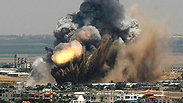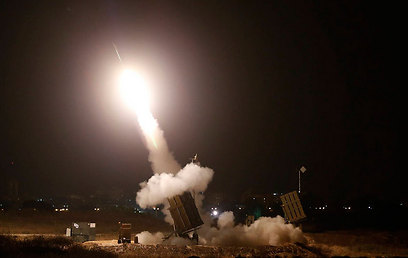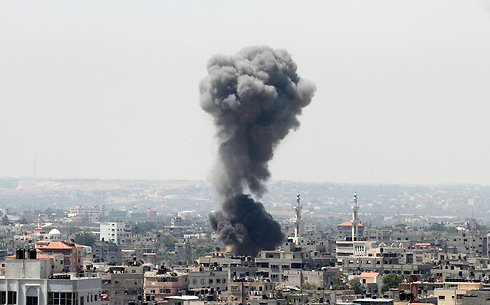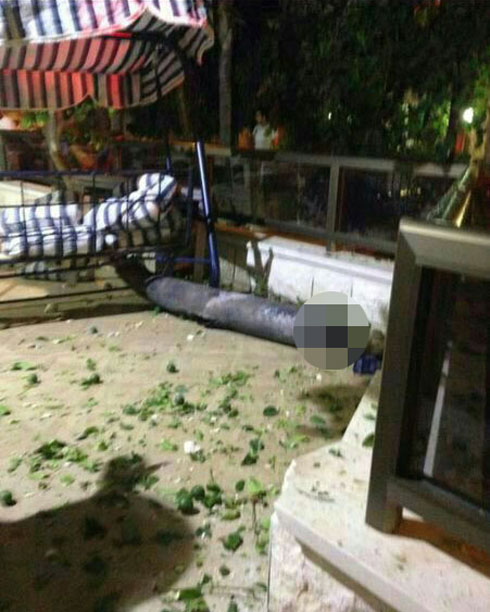
Terrorists' considerations: Where to aim, when and how many rockets to fire?
Analysis: Hamas and other Gaza terror organizations have learned from previous operations how to get past Iron Dome and how to escape the IDF's watchful eye.
One could already see in the opening stages of Operation Protective Edge that Hamas and the other Palestinian organizations in Gaza have learned from earlier operations. In Operation Cast Lead and even more so during Pillar of Defense, the Palestinians realized that they were at a severe military disadvantage in dealing with three challenges presented by the IDF.
The first challenge is the barrier of the missile interceptors that Israel introduced in the form of Iron Dome batteries. The second is the IDF's intelligence gathering capabilities on the ground, in the air and at sea. A range of sensors means that the IDF can track every movement on the ground – and fire upon it - both day and night.
The final challenge is the Israeli ability to provide a quick response based on intelligence and sensors delivering information in real time. This is an integral part of what is known as "canopy fire" – the ability to respond to Palestinian launch squads within minutes, once they are exposed via observation or other intelligence sources.
Hamas, Islamic Jihad and the Popular Resistance Committees have, in light of the conclusions they drew in previous bouts with Israel, taken steps in order to counter the challenges presented to them by the IDF. This is already evident.
For example, to counter Iron Dome, Hamas and the other Palestinian organizations are launching barrages of dozens of rockets and missiles at once. This is because the Palestinians believe that there's a limit to the number of rockets that Iron Dome can intercept. This is an open secret, known not only to Hamas and Islamic Jihad in Gaza, but also to Hezbollah in Lebanon.
In any event, the simultaneous launch of multiple rockets at one area does pose a challenge to Iron Dome. For this reason, Hamas and Islamic Jihad on Monday fired dozens of rockets simultaneously into the western Negev. They did so at longer ranges and in a very short time span, firing each time at a different area.
Single rockets were fired at points where Hamas wanted to show that it can reach longer ranges, such as Kiryat Malachi, the Rehovot area and so on. A few rockets were fired at these locations to send a message, and to test whether the IDF is sufficiently prepared to protect those places. One should remember that Gazans have neither an air force nor a sophisticated intelligence system to provide information about the locations of the Iron Dome batteries.
Another way of overcoming the challenge posed by Iron Dome is for Hamas and Islamic Jihad to use long-range, bigger rockets. They believe that the use of the batteries requires the IDF to thinly spread the Iron Dome batteries around, which would present it with a challenge by having to deal with numerous rocket barrages fired simultaneously. The greater the area that Iron Dome has to defend, the greater the chances that something will slip through the net.
To overcome the superiority of IDF intelligence in Gaza, the Palestinians have employed what is known by the military as "underground range". Quite simply, the Palestinians bury their launchers in prepared pits, making them hard to detect from the air and hard to hit precisely because of their below-ground location. These pits usually have covers that are opened either electronically or by pulling a connected rope. The launcher is powered by an electric switch, the rocket is launched and the cover replaced.
Maintenance tunnels have allowed Hamas militants to move a large number of these landfill launchers - pre-aimed towards a particular destination in Israel – around underground, and rearm them or change direction without being exposed through Israeli intelligence gathering.
The work to bury the launchers and dig these maintenance tunnels was carried out on a major scale, but there is nonetheless a downside. Firing hidden rockets does not means that the IDF cannot attack them, which it does sometimes within minutes from when the launchers were used. This is exactly what happened throughout the day on Tuesday, when we heard about repeated attacks by the Air Force, which Palestinians reported as strikes on open areas. Those attacks in purported open areas actually are the Air Force acting against buried materiel.
Weather advantage
Another important factor is the weather. Operations Cast Lead and Pillar of Defense took place in stormy winter, when the Gaza Strip was largely covered in the morning hours by thick clouds of fog. Although UAVs, helicopters and Air Force fighter jets can strike their targets even if they are not visible to the naked eye, or in poor conditions or bad weather, the launcher crews operating above ground would appear unexpectedly in different areas of the Gaza Strip, taking advantage of poor visibility to fire on Israel.
This is not the case in the cloudless July skies of Operation Protective Edge. The fine weather offers a clear advantage to the IDF, causing the Palestinians to rarely fire rockets during the day. Summer is not a good season for them. Firing late in the evening – for example between 8 and 9pm – is also intended to achieve the greatest impact, as this is when TV news shows are broadcast and the Gazans received the highest ratings.
Still playing by the rules
Despite the numerous threats emanating from Gaza, it seems that the factions are conducting themselves in the same way that the IDF has been managing the fighting so far. The phrase "calm will be met with calm" was replaced on both sides with "escalation will lead to escalation", but neither has yet reached the stage of breaking the rules.
Even Islamic Jihad, an organization more militant and more radical than Hamas, is keeping to rocket ranges that do not cross a red line for the IDF. Confirmation of this came Tuesday morning, when Abu Ahmad, a spokesman for the organization's military wing, said that, "Our operation will expand as Israeli aggression expands". The message here is quite clear - Islamic Jihad will increase its range of rocket fire only if and when Israel intensifies its own attacks. For now, neither side there yet, but this delicate equation could be shattered if there are multiple casualties in Gaza or, God forbid, in Israel.
The Hamas political leadership has vanished from the scene in recent days. The movement's leaders, headed by Ismail Haniyeh, are not appearing in public and are not delivering open messages to the Gazan people. Hamas senior official Moussa Abu Marzouk, who lives in Cairo and frequently visits Gaza, has not been to the Strip at all in recent weeks.
The only ones conveying messages from Hamas are its spokesmen and senior officials based abroad. Their concern is clear - Israel may take advantage of the situation and assassinate them. Haniyeh also knows that he no longer holds the official position of prime minister, and thus it would be easier for Israel to justify his assassination to the world.
On Tuesday morning, Islamic Jihad decided to call the operation "Unified Structure" – perhaps a hint at the cohesion of the Gaza factions in the escalation against Israel.














